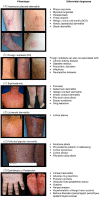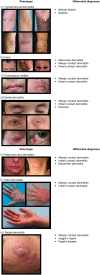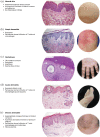Nomenclature and clinical phenotypes of atopic dermatitis
- PMID: 33854747
- PMCID: PMC8010850
- DOI: 10.1177/20406223211002979
Nomenclature and clinical phenotypes of atopic dermatitis
Abstract
Atopic dermatitis is a heterogeneous disease and resists classification. In this review, we discuss atopic dermatitis nomenclature and identify morphologic phenotypes, which will facilitate correct diagnoses and development of treatment strategies. We support using the term 'atopic dermatitis' rather than eczema, because it describes the allergic background and inflammation ('itis') as drivers of the disease. Atopic dermatitis has many morphologic manifestations that vary by topographic area affected, age, or race and require consideration in differential diagnosis. Different phenotypes based on morphology and topographic location, ethnicity, and age are discussed. A better-defined phenotype identification for atopic dermatitis will facilitate earlier and correct diagnosis of this complex condition and inform selection of the most appropriate treatment choice in an era in which targeted therapies may generate more individualized patient care.
Keywords: atopic; dermatitis; eczema; nomenclature; phenotype; treatment.
© The Author(s), 2021.
Conflict of interest statement
Conflict of interest statement: Dr. Giampiero Girolomoni has been principal investigator in sponsored clinical trials and received personal fees from AbbVie, Abiogen, Almirall, Amgen, Biogen, Boehringer Ingelheim, Bristol-Myers Squibb, Celgene, Celltrion, LEO Pharma, Lilly, Menlo Therapeutics, Merck, Merck Sharp & Dohme, Novartis, OM Pharma, Pfizer, Regeneron, Samsung, Sandoz, Sanofi Genzyme and UCB Pharma. Dr. Marjolein De Bruin-Weller has been principal investigator, advisory board member, and consultant for Regeneron, Sanofi Genzyme; principal investigator, and advisory board member for AbbVie, Pfizer, and Leo Pharma; and advisory board member for Lilly, UCB, Galderma, and Janssen. Dr. Valeria Aoki has received honoraria for lecturing from Sanofi. Dr. Kenji Kabashima has received consulting fees, honoraria, grant support, and lecturing fees from Japan Tobacco, LEO Pharma, Maruho, Mitsubishi Tanabe, Ono, Procter & Gamble, Sanofi, Taiho, and Torii. Dr. Mette Deleuran has received research support, honoraria for lecturing and is on consulting/advisory board agreements with AbbVie, Almirall, Galapagos, LEO Pharma, Lilly, Meda Pharma, Pfizer, Pierre Fabre, Regeneron, and Sanofi Genzyme. Dr. Luis Puig has received research support, honoraria for lecturing, and is on consulting/advisory board agreements with AbbVie, Almirall, Amgen, Baxalta, Biogen, Boehringer Ingelheim, Celgene, Gebro, Janssen, LEO Pharma, Lilly, Merck Serono, Merck Sharp & Dohme, Pfizer, Mylan, Novartis, Roche, Sandoz, Samsung Bioepis, Sanofi, and UCB. Dr Puig is also an Associate Editor of Therapeutic Advances in Chronic Disease and, therefore, the peer review process was managed by alternative members of the Board and the submitting Editor had no involvement in the decision-making process. Dr. Ashish Bansal is an employee and shareholder of Regeneron Pharmaceuticals, Inc. Dr. Ana B. Rossi is an employee and may hold stock and/or stock options in Sanofi Genzyme.
Figures






Similar articles
-
[On atopic dermatitis].Vestn Dermatol Venerol. 1989;(2):27-9. Vestn Dermatol Venerol. 1989. PMID: 2728600 Russian.
-
Flexural eczema versus atopic dermatitis.Dermatitis. 2015 May-Jun;26(3):109-15. doi: 10.1097/DER.0000000000000102. Dermatitis. 2015. PMID: 25984686 Review.
-
What's new in atopic eczema? An analysis of systematic reviews published in 2016. Part 3: nomenclature and outcome assessment.Clin Exp Dermatol. 2019 Jun;44(4):376-380. doi: 10.1111/ced.13886. Epub 2019 Jan 31. Clin Exp Dermatol. 2019. PMID: 30706507
-
Distinct SPINK5 and IL-31 polymorphisms are associated with atopic eczema and non-atopic hand dermatitis in Taiwanese nursing population.Exp Dermatol. 2011 Dec;20(12):975-9. doi: 10.1111/j.1600-0625.2011.01374.x. Epub 2011 Oct 20. Exp Dermatol. 2011. PMID: 22017185
-
Phenotypes of Atopic Dermatitis Depending on the Timing of Onset and Progression in Childhood.JAMA Pediatr. 2017 Jul 1;171(7):655-662. doi: 10.1001/jamapediatrics.2017.0556. JAMA Pediatr. 2017. PMID: 28531273 Free PMC article.
Cited by
-
Exploring Young Adults' Experiences of Atopic Dermatitis Self-Management and Use of Community Pharmacy: A Qualitative Study.Health Expect. 2025 Aug;28(4):e70378. doi: 10.1111/hex.70378. Health Expect. 2025. PMID: 40771045 Free PMC article.
-
Overview of Atopic Dermatitis in Different Ethnic Groups.J Clin Med. 2023 Apr 4;12(7):2701. doi: 10.3390/jcm12072701. J Clin Med. 2023. PMID: 37048783 Free PMC article. Review.
-
Blocking the IL-4/IL-13 Axis versus the JAK/STAT Pathway in Atopic Dermatitis: How Can We Choose?J Pers Med. 2024 Jul 22;14(7):775. doi: 10.3390/jpm14070775. J Pers Med. 2024. PMID: 39064029 Free PMC article. Review.
-
Children atopic dermatitis: Diagnosis, mimics, overlaps, and therapeutic implication.Dermatol Ther. 2022 Dec;35(12):e15901. doi: 10.1111/dth.15901. Epub 2022 Oct 13. Dermatol Ther. 2022. PMID: 36200594 Free PMC article. Review.
-
Burden of Disease; the Current Status of the Diagnosis and Management of Atopic Dermatitis in China.J Clin Med. 2023 Aug 18;12(16):5370. doi: 10.3390/jcm12165370. J Clin Med. 2023. PMID: 37629411 Free PMC article. Review.
References
-
- Barbarot S, Auziere S, Gadkari A, et al.. Epidemiology of atopic dermatitis in adults: results from an international survey. Allergy 2018; 73: 1284–1293. - PubMed
-
- Bieber T. Atopic dermatitis. N Engl J Med 2008; 358: 1483–1494. - PubMed
-
- Nutten S. Atopic dermatitis: global epidemiology and risk factors. Ann Nutr Metab 2015; 66(Suppl. 1): 8–16. - PubMed
-
- Yew YW, Thyssen JP, Silverberg JI. A systematic review and meta-analysis of the regional and age-related differences in atopic dermatitis clinical characteristics. J Am Acad Dermatol 2019; 80: 390–401. - PubMed
-
- Bieber T, D’Erme AM, Akdis CA, et al.. Clinical phenotypes and endophenotypes of atopic dermatitis: where are we, and where should we go? J Allergy Clin Immunol 2017; 139: S58–S64. - PubMed
LinkOut - more resources
Full Text Sources
Other Literature Sources

